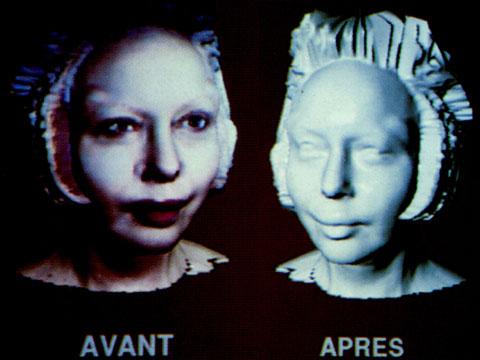
In «The Reincarnation of Saint Orlan,» the artist underwent facial surgery in order to make specific characteristic features from the world of art history appear more alive. Her ‹models› were Venus, Diana, Europa, Psyche, and Mona Lisa. In the process, not only were her face and body treated for the first time as a collage and manipulated (as demonstrated in the 1970s, for example, by Valie Export, Ulrike Rosenbach, and by Orlan herself), but also permanently demonstrated in keeping with a consciously anti-aesthetical criteria—since Orlan’s operations were also staged as medial events for the video camera. The consistently practiced artistic pose and stylization of the self leads here to the artificiality of all the operative corrections becoming heightened to the negative extreme, and manifesting themselves in their own hybrid state.
Also see the exhibitions «Omniprésence» (1993) and «Ceci est mon corps...ceci est mon logiciel».
Rudolf Frieling
Orlan is a performance artist who uses her own body and the procedures of plastic surgery to make "carnal art". She is transforming her face, but her aim is not to attain a commonly held standard of beauty. Orlan is the only artist working so radically with her own body, asking questions about the status of the body in society.
In 1971 she baptized herself "Saint Orlan," festooning her body with billowing draperies made of black vinyl or white leatherette. She exhibited these elaborate sculptural costumes in a show in Milan in 1972. Soon she began to wear her ever more exaggerated faux- Baroque costumes in staged tableaux vivants. High contrast color photographs of Saint Orlan, both living doll and living sculpture, were integrated into photo- collages, videos and films tracing a fictive hagiography.
"Convinced that with its exaggerated emotionalism Bernini's St. Teresa in Ecstasy was the first postmodernist sculpture, Orlan found relationships between the forced pathos of Counter- Reformation esthetics and the historical references of contemporary artistic practice. The prototype image of Saint Orlan was a marble sculpture she carved and then, in the tradition of academic sculpture since the Renaissance, sent to be enlarged or 'pointed up' to full scale. Her incarnation as Saint Orlan focused on the hypocrisy of the way society has traditionally split the female image into madonna and whore. She played off this long- entrenched dichotomy by exposing only one breast (as the nursing Virgin Mary is depicted), to differentiate Saint Orlan from a topless pinup. (The single exposed breast also referred to the Amazons of ancient mythology, represented as having only one breast to be free to sling warriors' quivers over exposed chests.)" (Barbara Rose, Art in America)
1977 was an important year for Orlan. Her sculpture and performance 'The kiss of the artist', based on the texts 'Facing a society of mothers and merchants' and 'Art and prostitution', written in collaboration with Hubert Besacier, gave her a name in the world of art. It became subject of a scandal and caused a lot of reactions, either negative or positive.Orlan stationed herself outside the Grand Palais, site of FIAC, the French art fair, next to a life- size photo of her torso transformed into a slot machine that she identified as an automatic kiss- vending object. Customers who inserted five francs in the slot between the breasts could watch the coin descend to the crotch, at which point the live artist jumped off her pedestal to reward the purchaser with a real kiss (Rose).
Entitled The Reincarnation of Saint Orlan, she has since May 1990 undergone a series of plastic surgical operations to transform herself into a new being, modelled on Venus, Diana, Europa, Psyche and Mona Lisa.
Drawing attention to the man-made (or "ready-made) construct of beauty. After her third surgery in 1990, she donned this Bride of Frankensteing wig for a portrait. The image is intended to draw attention to the notion that female beauty is constructed by men for the pleasure of men.
In 1998 she collaborated with Pierre Zoville for an exhibition in the museum Carillo Gil in Mexico. Together they made new pictures and manipulated them with a computer and interactive video installations inspired by the bodytransformations in Maya and Olméques culture.

No comments:
Post a Comment